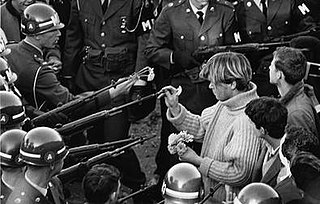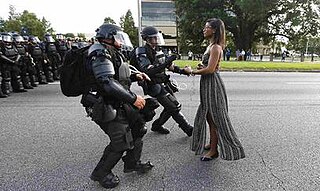
Taksim Square, situated in Beyoğlu in the European part of Istanbul, Turkey, is a major tourist and leisure district famed for its restaurants, shops, and hotels. It is considered the heart of modern Istanbul, with the central station of the Istanbul Metro network. Taksim Square is also the location of the Republic Monument which was crafted by Pietro Canonica and inaugurated in 1928. The monument commemorates the 5th anniversary of the foundation of the Republic of Turkey in 1923, following the Turkish War of Independence.

Egemen Bağış is a former Turkish politician of, former member of the Turkish parliament, the former minister for EU Affairs and chief negotiator of Turkey in accession talks with the European Union and a former ambassador of Turkey to the Czech Republic.

Neda Agha-Soltan was an Iranian student of philosophy, who was participating in the 2009 presidential election protests with her music teacher, and was walking back to her car when she was fatally shot in the upper chest.
The word serhildan describes several Kurdish protests and uprisings since the 1990s that used the slogan "Êdî Bese" ("Enough") against Türkiye. Local shops are often closed on the day of demonstrations as a form of protest.
The 2011–2012 Kurdish protests in Turkey were protests in Turkey, led by the Peace and Democracy Party (BDP), against restrictions of Kurdish rights by of the country's Kurdish minority's rights. Although they were the latest in a long series of protest actions by Kurds in Turkey, they were strongly influenced by the concurrent popular protests throughout the Middle East and North Africa, and the Turkish publication Hürriyet Daily News has suggested that the popularly dubbed "Arab Spring" that has seen revolutions in Egypt and Tunisia may lead to a "Kurdish Summer" in the northern reaches of the Middle East. Protesters have taken to the streets both in Istanbul and in southeast Turkey, with some demonstrations also reported as far west in Anatolia as İzmir.

LGBTQ history in Turkey covers the development, contributions and struggles of lesbian, gay, bisexual, transgender, and queer (LGBTQ) people in the history of Turkey and their relation between Turkish politics from the abolition of the Caliphate to modern-day Turkey.

The UC Davis pepper spray incident occurred on November 18, 2011, during an Occupy movement demonstration at the University of California, Davis. After asking the protesters to leave several times, university police pepper sprayed a group of student demonstrators as they were seated on a paved path in the campus quad. The video of UC Davis police officer Lt. John Pike pepper-spraying demonstrators spread around the world as a viral video and the photograph became an Internet meme. Officer Alex Lee also pepper sprayed demonstrators at Pike's direction.

Flower Power is the title of a photograph taken by American photographer Bernie Boston for the now-defunct newspaper The Washington Evening Star. Taken on October 21, 1967, during the March on the Pentagon by the National Mobilization Committee to End the War in Vietnam, the photo shows protester George Harris placing a carnation into the barrel of an M14 rifle held by a soldier of the 503rd Military Police Battalion (Airborne).

A wave of demonstrations and civil unrest in Turkey began on 28 May 2013, initially to contest the urban development plan for Istanbul's Taksim Gezi Park. The protests were sparked by outrage at the violent eviction of a sit-in at the park protesting the plan. Subsequently, supporting protests and strikes took place across Turkey, protesting against a wide range of concerns at the core of which were issues of freedom of the press, of expression and of assembly, as well as the AKP government's erosion of Turkey's secularism. With no centralised leadership beyond the small assembly that organised the original environmental protest, the protests have been compared to the Occupy movement and the May 1968 events. Social media played a key part in the protests, not least because much of the Turkish media downplayed the protests, particularly in the early stages. Three and a half million people are estimated to have taken an active part in almost 5,000 demonstrations across Turkey connected with the original Gezi Park protest. Twenty-two people were killed and more than 8,000 were injured, many critically.
The following is a timeline of the Gezi Park protests in Turkey of citizens and supporters against actions and plans of the government of Turkey. The timeline is segmented into days.
The 2013 Gezi Park protests in Turkey saw massive amounts of censorship and disinformation by the mainstream media, especially by those supporting Prime Minister Recep Tayyip Erdoğan and his Justice and Development Party (AKP). A poll done by Istanbul Bilgi University in the first week of the protests showed that 84% of the demonstrators cited the lack of media coverage as a reason to join the protests, higher than the 56% of protesters who referred to the destruction of Gezi Park.
During the Gezi Park protests in Turkey, police forces repeatedly used excessive force to prevent and disperse peaceful demonstrations. As a result, it is estimated that there were 22 fatalities and least at least 8,163 injuries, of which 63 in serious or critical condition.
The AKP government's handling of the 2013–14 protests in Turkey has been roundly criticized by other nations and international organizations, including the European Union, the United Nations, the United States, the UK, and Germany.
Berkin Elvan was a 15-year-old boy who was hit on the head by a tear-gas canister fired by a police officer in Istanbul during the June 2013 anti-government protests in Turkey. He died on March 11, 2014. Lawyers representing the family said Elvan's condition worsened over the last week of his life, with his weight dropping to 16 kg from 45 kg. Widespread demonstrations erupted following Berkin's death.

Erdem Gündüz is a Turkish dancer, actor, performance artist, choreographer, and teacher who, as a result of his actions during the 2013–14 protests in Turkey, has become "the face of the protest movement against the Turkish government." He became internationally known as "The Standing Man" in June 2013 when he stood quietly in Istanbul's Taksim Square as a protest against the conservative government of Recep Tayyip Erdoğan.

Taking a Stand in Baton Rouge is a photograph of Ieshia Evans, a nurse from Pennsylvania, being arrested by police officers dressed in riot gear during a protest in Baton Rouge, Louisiana, on 9 July 2016. The protest began in the aftermath of the shooting by police of Alton Sterling and Philando Castile. The image, taken by Jonathan Bachman for Reuters, became a viral phenomenon on social media, described by several media organizations as "iconic", with some comparing the image to well-known images of other lone protesters, such as the photograph of "Tank Man" in the Tiananmen Square protests of 1989.
Ceyda Sungur, also known as Kırmızılı Kadın, is a Turkish academic and activist.

Dorli Rainey was an Austrian-American political activist. After being pepper-sprayed at an Occupy Seattle protest by police, she became one of the faces of the Occupy Wall Street movement.









